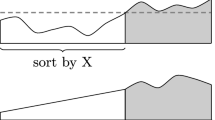Abstract
We present a new priority queue data structure, the queap, that executes insertion in O(1) amortized time and Extract-min in O(log(k + 2)) amortized time if there are k items that have been in the heap longer than the item to be extracted. Thus if the operations on the queap are first-in first-out, as on a queue, each operation will execute in constant time. This idea of trying to make operations on the least recently accessed items fast, which we call the queueish property, is a natural complement to the working set property of certain data structures, such as splay trees and pairing heaps, where operations on the most recently accessed data execute quickly. However, we show that the queueish property is in some sense more difficult than the working set property by demonstrating that it is impossible to create a queueish binary search tree, but that many search data structures can be made almost queueish with a O(log log n) amortized extra cost per operation.
Research is supported by grants from MITACS, FCAR and CRM.
Access this chapter
Tax calculation will be finalised at checkout
Purchases are for personal use only
Preview
Unable to display preview. Download preview PDF.
Similar content being viewed by others
References
G. M. Adel’son-Vel’skii and E. M. Landis. An algorithm for the organization of information. Soviet. Math., 3:1259–1262, 1962.
R. Cole. On the dynamic finger conjecture for splay trees. Part II: The proof. Technical Report Computer Science TR1995-701, New York Univerity, 1995.
R. Cole, B. Mishra, J. Schmidt, and A. Siegel. On the dynamic finger conjecture for splay trees. Part I: Splay sorting log n-block sequences. Technical Report Computer Science TR1995-700, New York Univerity, 1995.
E. Demaine, J. Iacono, and S. Langerman. Proximate point searching. In Proc. 14th Canad. Conf. on Computational Geometry, pages 1–4, 2002.
L. Devroye. Nonuniform random variate generation. Springer-Verlag, New York, 1986.
M. L. Fredman, R. Sedgewick, D. D. Sleator, and R. E. Tarjan. The pairing heap: A new form of self-adjusting heap. Algorithmica, 1:111–129, 1986.
M. T. Goodrich, M. Orletsky, and K. Ramaiyer. Methods for achieving fast query times in point location data structures. In Proc. 8th ACM-SIAM Sympos. Discrete Algorithms, pages 757–766, 1997.
S. Huddland K. Mehlhorn. A new data structure for representing sorted lists. Acta Inform., 17:157–184, 1982.
J. Iacono. Improved upper bounds for pairing heaps. In 7th Scandinavian Workshop on Algorithm Theory, pages 32–45, 2000.
J. Iacono. Alternatives to splay trees with O(log n) worst-case access times. In Proc. 12th ACM-SIAM Sympos. Discrete Algorithms, pages 516–522, 2001.
J. Iacono. Distribution Sensitive Data Structures. PhD thesis, Rutgers University New Brunswick, 2001.
D. G. Kirkpatrick. Optimum search in planar subdivisions. SIAM J. Comput., 12(1):28–35, 1983.
D. Maier and S. C. Salveter. Hysterical B-trees. Inform. Process. Lett., 12:199–202, 1981.
D. D. Sleator and R. E. Tarjan. Self-adjusting binary trees. JACM, 32:652–686, 1985.
D. D. Sleator and R. E. Tarjan. Self-adjusting heaps. SIAM Journal of Computing, 15:52–69, 1986.
R. Sundar. Amoritzed Complexity of Data Structures. PhD thesis, New York University, 1991.
R. E. Tarjan. Sequential access in splay trees takes linear time. Combinatorica, 5:367–378, 1985.
R. Wilbur. Lower bounds for accessing binary search trees with rotations. In Proc. 27th Symp. on Foundations of Computer Science, pages 61–69, 1986.
Author information
Authors and Affiliations
Editor information
Editors and Affiliations
Rights and permissions
Copyright information
© 2002 Springer-Verlag Berlin Heidelberg
About this paper
Cite this paper
Iacono, J., Langerman2, S. (2002). Queaps. In: Bose, P., Morin, P. (eds) Algorithms and Computation. ISAAC 2002. Lecture Notes in Computer Science, vol 2518. Springer, Berlin, Heidelberg. https://doi.org/10.1007/3-540-36136-7_19
Download citation
DOI: https://doi.org/10.1007/3-540-36136-7_19
Published:
Publisher Name: Springer, Berlin, Heidelberg
Print ISBN: 978-3-540-00142-3
Online ISBN: 978-3-540-36136-7
eBook Packages: Springer Book Archive




